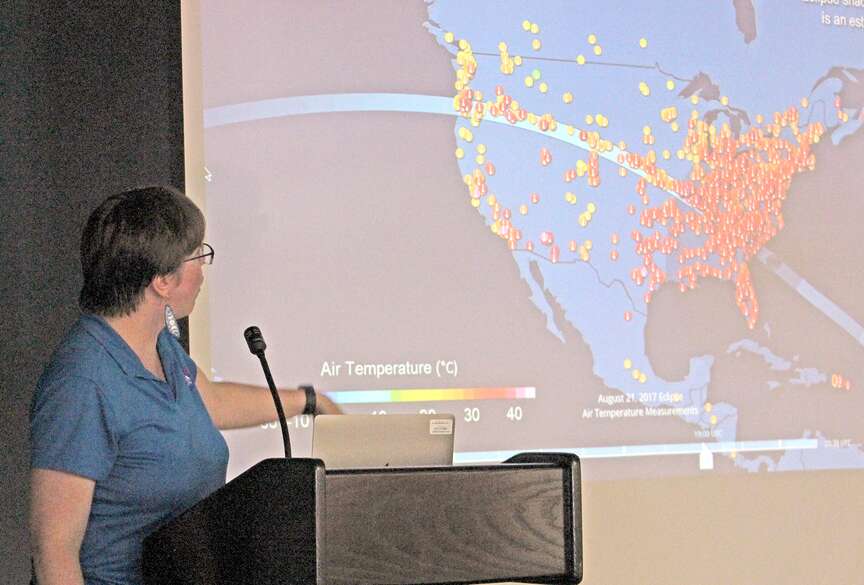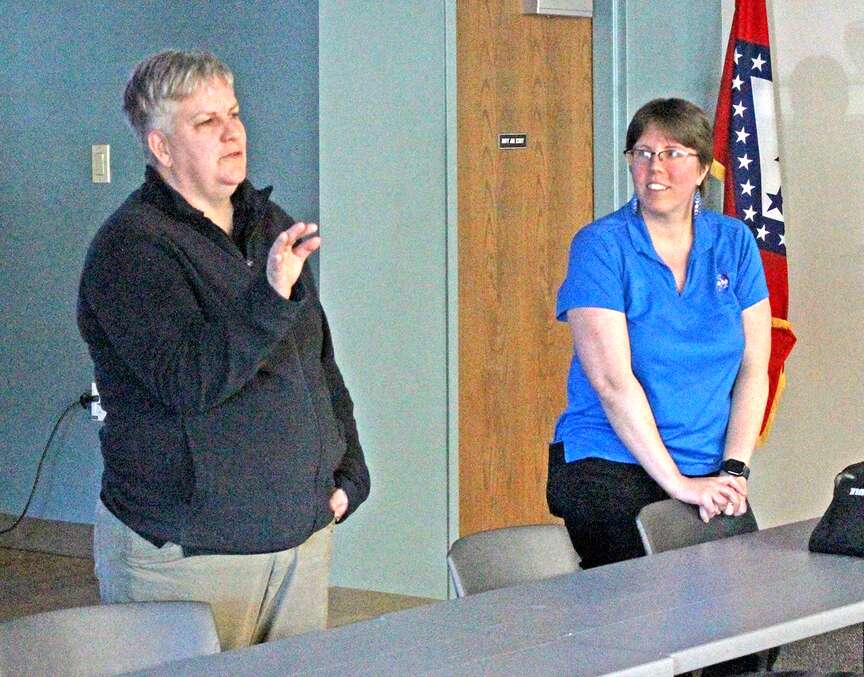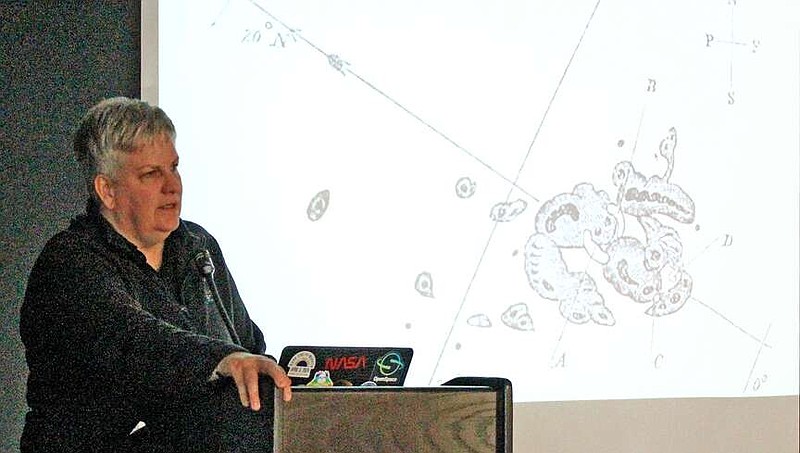HOT SPRINGS -- The public can take part in helping NASA scientists learn more about eclipses during today's total solar eclipse, NASA's Kristen Weaver told attendees at a talk at the Garland County Library on Thursday.
The deputy coordinator of NASA's Global Learning and Observations to Benefit the Environment Observer program was joined by Earth to Sky Eclipse Coordinator Cris White to discuss what scientists have learned over the years from total solar eclipses.
"The GLOBE program is a science education and community program looking at how we study the Earth and the environment around us, and it's been around since 1995," Weaver said.
The program is sponsored by NASA but also supported by the National Science Foundation, the National Oceanic and Atmospheric Administration and the U.S. State Department "because it is actually international," she said, noting 127 countries around the world have it.
"It started out being teachers doing data collection with their students with the GLOBE Observer app, which is the part of the project that I specifically work on. That now opens it up to anybody who's interested in collecting data that has a connection to NASA satellite data especially."
With today's total solar eclipse, the program hopes to gather information similar to what was gleaned from a March 2015 experiment involving a partial solar eclipse in the United Kingdom where people were asked to track temperature changes during the event.
"This research was what gave us the idea to create the eclipse tool for the GLOBE Observer app," Weaver said. "So we launched GLOBE Observer in 2016, and then of course, we had the 2017 eclipse in August of 2017. This project was like, 'Oh, we could do something like that. Let's see what kind of data we can collect.'"
Weaver said data from citizen scientists and weather stations have both advantages and disadvantages.
"We recognize that people are using different types of thermometers," she said. "They may have a little bit of training but are not necessarily experts, but still there's a lot of data. There are fewer observations per observer potentially but overall, a lot of observations. Whereas if you've got a weather station, there's not very many of them, and they're fixed. There's only going to be a certain number in totality, and they usually have more quality control data, and they have more numbers, but still, there's advantages and disadvantages."
Weaver said the app, which is available for free at observer.globe.gov, walks people through how to collect data during the eclipse in addition to data that can be collected anytime.
"We tried to make it pretty simple and pretty straightforward with lots of instructions in the app," she said.
White said the first recorded observations of a total solar eclipse were more than 1,500 years ago.
"We are beings of light, and in the afternoon of April 8, as you well know, a total solar eclipse will come across from Texas, actually from Mexico, all the way up through Canada, Nova Scotia," she said.
"And during such events, it affords scientists the opportunity to study the sun's corona, the sun itself and the space between the sun and Earth in greater detail as the moon blocks the entire surface of the sun. The first recorded observations of the solar corona occurred during the total solar eclipse on Dec. 22 of 968. Byzantine historian [Leo] Diaconus observed the event in Constantinople."
While she admitted it is unlikely, White said she hopes to see a coronal mass ejection during the eclipse as the sun is nearing "solar maximum," where the star reaches the peak of an 11-year activity cycle. She noted these events can cause solar storms, which can affect electrical devices.
The Carrington Event, a solar storm caused by large solar flares noted by Richard Carrington in 1859, was so strong that telegraph machines were sparking, leading operators to unplug them from their batteries.
"The next morning, they got ready to plug in the telegraph machines, and they were still buzzing," White said. "I think everyone was probably a little nervous to connect up to the batteries. So they actually tried communicating with each other, and it worked just off of the electric field that was on the surface of the Earth from that solar storm."
White noted solar flares are natural phenomena caused by the shifting of the sun's magnetic field.
"What happens is you get these loose magnetic loops that pull plasma from the surface of the sun, and they'll jump from one sunspot to the next," she said. "But then occasionally, they'll get so massive, they'll jump even farther. And so they're expanding several sunspots. And when you get that much bulk and that magnetic field and the pressure is building underneath, eventually they'll fly off as a coronal mass ejection."
Multiple scientists, from Edmund Halley to Albert Einstein, have made discoveries based on the sun. In fact, White said Einstein's theory of general relativity was formulated based on observations of the sun.
"In 1915, you might recognize this name, a young Albert Einstein was hearing around the scientific world the rumors of a planet called Vulcan," she said. "And they were basing this off of the fact that Mercury seemed to be tugged on in its orbit, so they were like trying to figure out what's pulling on Mercury.
"Einstein's like, 'I think if there was another planet, we would see it.' It's pretty smart. And so, he was trying to think of other reasons this might be happening, and he came up with general relativity, which basically states that space and time can be bent by massive objects, and this includes bending of light."
 NASA's Deputy Coordinator of the Global Learning and Observations to Benefit the Environment Observer program Kristen Weaver points out some of the temperature changes observed during the 2017 total solar eclipse during a presentation at the Garland County Library Thursday. (The Sentinel-Record/James Leigh)
NASA's Deputy Coordinator of the Global Learning and Observations to Benefit the Environment Observer program Kristen Weaver points out some of the temperature changes observed during the 2017 total solar eclipse during a presentation at the Garland County Library Thursday. (The Sentinel-Record/James Leigh) Earth to Sky Eclipse Coordinator Cris White, left, answers a question from the audience following a presentation at the Garland County Library Thursday as NASA's Deputy Coordinator of the Global Learning and Observations to Benefit the Environment (GLOBE) Observer program Kristen Weaver looks on. (The Sentinel-Record/James Leigh)
Earth to Sky Eclipse Coordinator Cris White, left, answers a question from the audience following a presentation at the Garland County Library Thursday as NASA's Deputy Coordinator of the Global Learning and Observations to Benefit the Environment (GLOBE) Observer program Kristen Weaver looks on. (The Sentinel-Record/James Leigh)